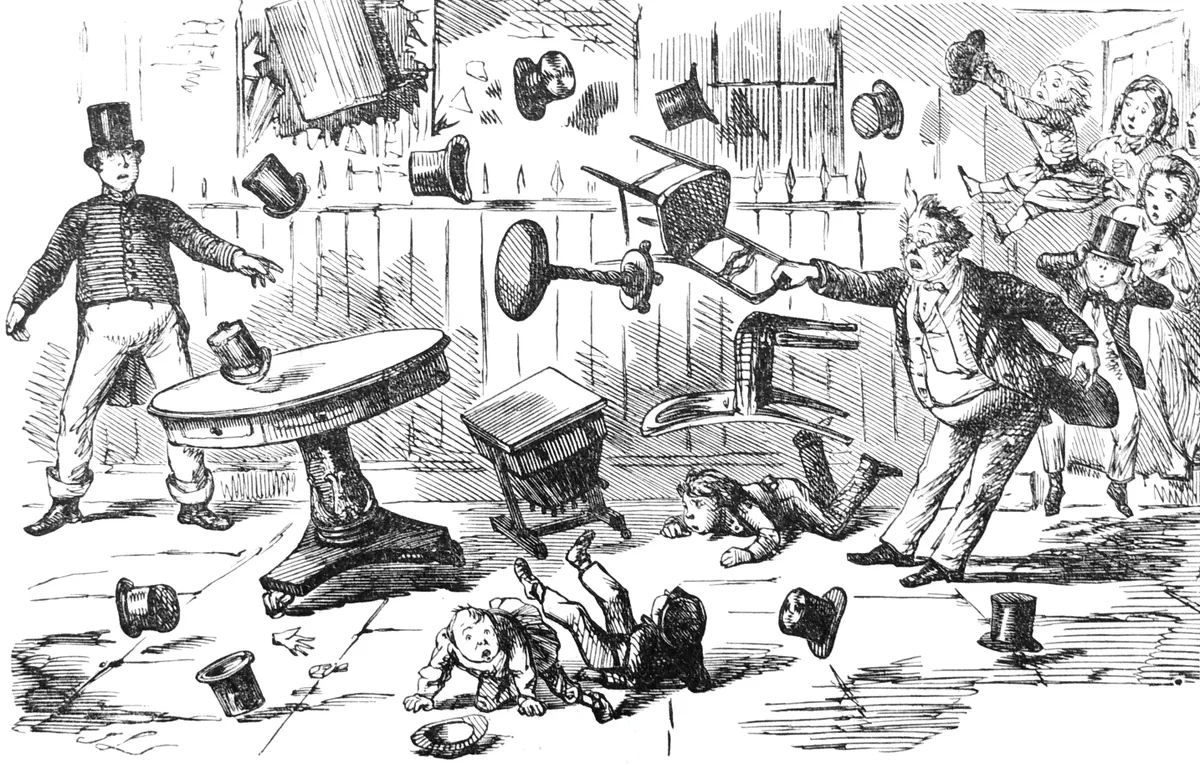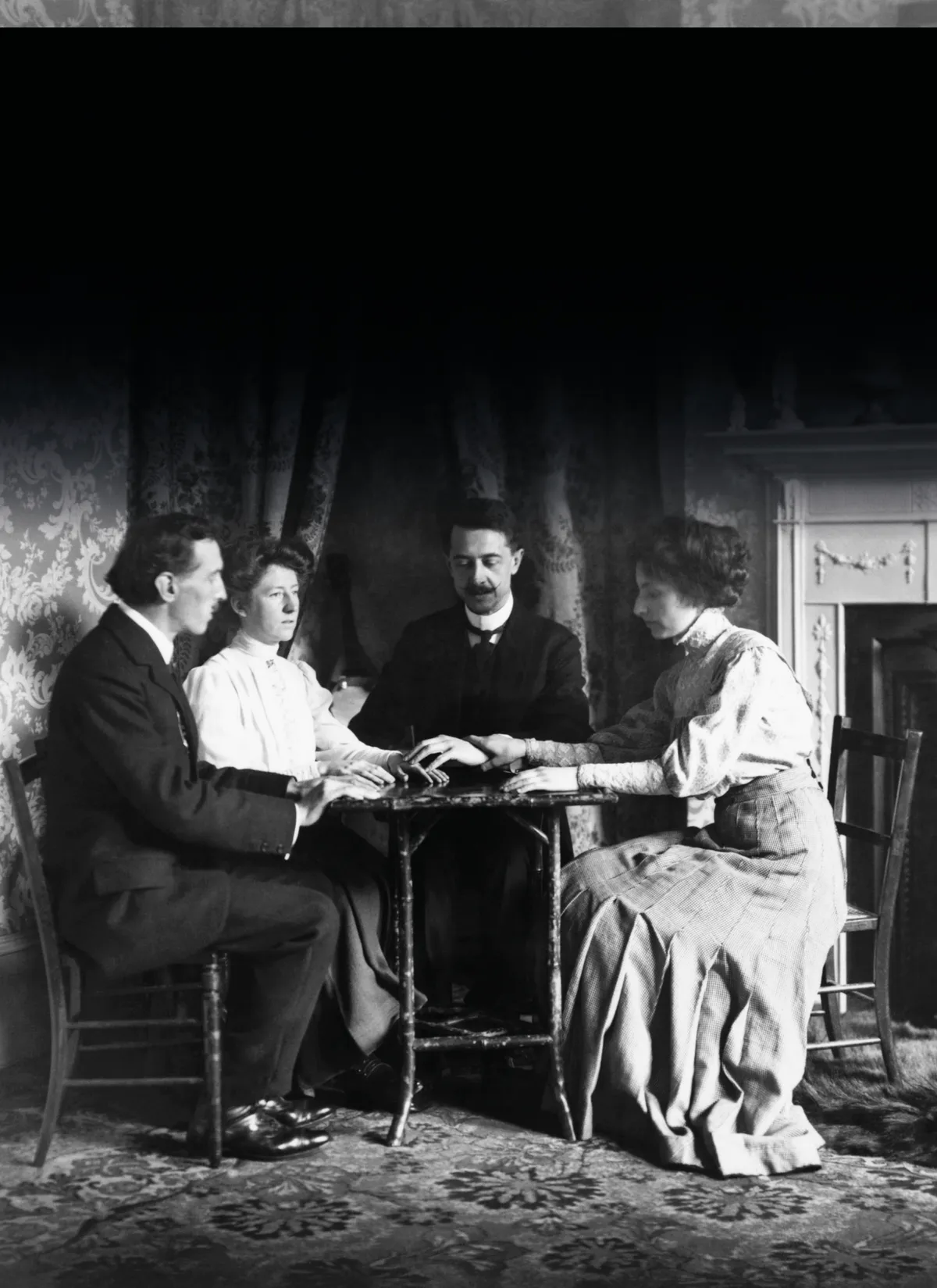In the Victorian age spiritualism – the belief that the ghosts of the dead could be contacted by the living – was increasingly popular. The spiritualist movement began with Margaretta and Catherine Fox, teenage girls in New York State who claimed, in 1848, that they could communicate with a ghost haunting the farmhouse where they lived by means of stamping their feet, with the spirit rapping in return.
British interest in spiritualism was stirred up after a visit from the American medium Maria B Hayden. She had begun her mediumship in 1851 at the age of 25 at a séance in New England. By the following year she was in England advertising her services, charging half a guinea for her sittings.
Séances were led by a medium who would try to communicate with the dead. Mysterious happenings often occurred – spirit rappings, voices emerging from the medium’s mouth or automatic handwriting guided by the spirit. Visual spectacles increased over the next few decades, as manifestations became more intricate in a bid to keep the attention of the sitters. Furniture moved, musical instruments seemed to play themselves and materialisations such as ghostly hands or even whole bodies appeared. The more incredible and inexplicable sightings helped to forge a medium’s reputation.

The first spiritualist church was established in Keighley, Yorkshire, in 1853, and the north became a stronghold of working-class spiritualism. Newspapers and journals emerged asserting the merits of the spiritualist faith; the first, the Yorkshire Spiritual Telegraph, was published in 1855, and ran for two years. One of the contributors was London-born Emma Hardinge Britten, an advocate for the nascent British spiritualist movement. She eventually became a medium, her background training as an opera singer and stage actor lending itself well to her new work. She travelled to America to display her talents, predicting the future for people, telling them of her visions, and pre-emptively playing songs on the piano that her audience were about to request. Many young mediums went on to have a working life on the stage.
In London, the Charing Cross Spirit-Power Circle was formed in 1857, and grew at a fast rate; it is now the Spiritualist Association of Great Britain. Women became notably prominent in the movement. It was thought that women picked up supernatural powers more easily than men, and were more likely to be gifted with a natural inclination towards speaking to the dead.
Although many of the earlier mediums were older women, pretty young girls also took up the opportunity of making a living. Typical of this new breed was 16-year-old Mary Rosina Showers, who emerged on the scene in May 1872. She was the daughter of a general in the Bombay army; it was alleged that she could see spirits when she was a child. A séance with her family produced all the usual manifestations, most notably the spirit form of a ‘John King’ and an entity called ‘Peter’. Two years later her mother took her to London from Teignmouth, and she started to give séances.
A supporter, author Florence Marryat, was impressed enough to write about her in There is No Death (1891). Her close connection with Showers set the spirits off: “We could not sit next [to] each other at an ordinary tea or supper table when we had no thought of or desire to hold a séance, without manifestations occurring in the full light. A hand that did not belong to either of us would make itself apparent under the table-cloth between us – a hand with power to grasp ours…”

By the 1870s there were numerous spiritualist societies and churches throughout the country, with little consensus among them about basic doctrines of spiritualism. Spiritualist churches were informal gatherings, unconnected to any official ecclesiastical body. Most of the attendees came together to hold readings or undertake clairvoyance in order to commune with the spirits of the dead; some might hold mediumship classes or conduct healing; some believed in God, others asserted that spiritualism was its own religion.
New ways of looking at the world were emerging. Conflicts between orthodox religion and Charles Darwin’s new theory of evolution through natural selection had already erupted with the publication of his book On the Origin of Species in 1859. Whether or not the emergence of spiritualism was a crisis in faith as a result of scientific assertions or simply a new splintered form of orthodox religion, it won increasing status. Eminent men declared themselves supporters; naturalist Alfred Russel Wallace, another proponent of natural selection, called himself a friend of the plebeian spiritualists and believed that the entities they were witnessing could be scientifically explained.
Sceptics were beginning to question how the manifestations were being made, as séances became increasingly theatrical with ghostly apparitions, ectoplasm and floating entities. In 1876 the Spiritual Magazine warned that “these days… trickery in connection with Spiritualism is so rife that it threatens to swamp the entire movement”. Conjurors, journalists and scientists were invited to séances to witness the phenomena, and some debunkers caught mediums out in acts of fraud. However, in many cases they found no evidence of fakery. Some even changed tack after witnessing a particularly triumphal manifestation, and professed spiritualism to be real.
The Society for Psychical Research was founded in 1882 by a group of leading thinkers to investigate mediumship, mesmerism, apparitions and other inexplicable phenomena. Their aim was “to approach these varied problems without prejudice or prepossession of any kind, and in the same spirit of exact and unimpassioned enquiry which has enabled science to solve so many problems, once not less obscure nor less hotly debated”. Early members included classical scholar Frederic WH Myers and philosopher and economist Henry Sidgwick, who both concentrated on exposing fraud.
Escapologist Harry Houdini and novelist Arthur Conan Doyle became friends, both sharing an interest in spiritualism. After witnessing one séance Conan Doyle declared himself a believer, while Houdini spent his life searching for evidence of life after death, while exposing the tricks of fraudulent mediums. Their friendship deteriorated after Conan Doyle’s wife, who was a medium, claimed to have automatically written a letter by Houdini’s mother – however, it was in English, a language that Houdini’s Hungarian mother hardly spoke.
Séances gradually diminished in popularity as more mediums were exposed as tricksters. Philosopher George Henry Lewes may be best known today for his long relationship with Mary Ann Evans, the real name of novelist George Eliot. Lewes published an article claiming to have caught Maria B Hayden out by submitting a trick question to her ‘spirit’ asking if she was a fraud. Nonetheless, after returning to America Hayden graduated as a doctor and was fêted for her healing powers.
Mary Rosina Showers was eventually unmasked on 2 April 1894 at the house of lawyer and publisher Edward William Cox. At her séances the medium would withdraw behind a makeshift cabinet, then apparently fall into a trance and manifest the spirit ‘Florence Maple’ who showed her face through an opening in the cabinet’s curtained doorway. However, instead of politely maintaining her position in the circle with the other sitters, Cox’s daughter jumped up and grabbed ‘Florence’. She pulled the drapery off the ‘spirit’, revealing her to be Showers. According to Edward Cox, a voice cried out “You have killed my medium!” – an obvious attempt at distraction. After much shrieking, the medium was put to bed in an apparent delirium.
The Fox sisters themselves eventually admitted that communication with the dead at their séances had all been hoaxes. However, belief in spiritualism survived the end of the Victorian era and continues to this day, with many churches holding meetings where believers pray and channel spirits.








